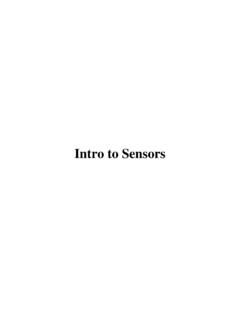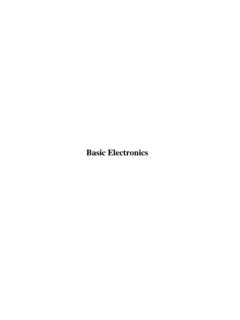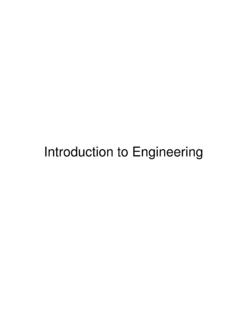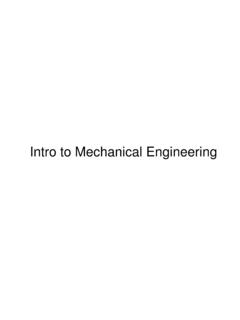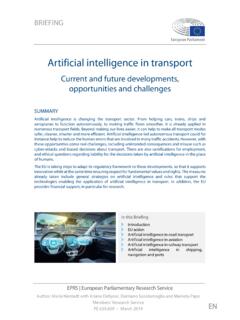Transcription of Intro to Mechatronics
1 Intro to Mechatronics Mechatronics Defined I. The name [ Mechatronics ] was coined by Ko Kikuchi, now president of Yasakawa Electric Co., Chiyoda-Ku, Tokyo.. R. Comerford, Mecha what? IEEE Spectrum, 31(8), 46-49, 1994. The word, Mechatronics is composed of mecha from mechanics and tronics from electronics. In other words, technologies and developed products will be incorporating electronics more and more into mechanisms, intimately and organically, and making it impossible to tell where one ends and the other begins.. T. Mori, Mechatronics , Yasakawa Internal Trademark Application Memo, , July 12, 1969. Mechanics mecha Mechatronics Eletronics tronics Mechatronics Defined II.
2 Integration of electronics, control engineering, and mechanical engineering.. W. Bolton, Mechatronics : Electronic Control Systems in Mechanical Engineering, Longman, 1995. Application of complex decision making to the operation of physical systems.. D. M. Auslander and C. J. Kempf, Mechatronics : Mechanical System Interfacing, Prentice-Hall, 1996. Synergistic integration of mechanical engineering with electronics and intelligent computer control in the design and manufacturing of industrial products and processes.. F. Harshama, M. Tomizuka, and T. Fukuda, Mechatronics -what is it, why, and how?-and editorial, IEEE/ASME Trans. on Mechatronics , 1(1), 1-4, 1996.
3 Mechatronics Defined III. Synergistic use of precision engineering, control theory, computer science, and sensor and actuator technology to design improved products and processes.. S. Ashley, Getting a hold on Mechatronics , Mechanical Engineering, 119(5), 1997. Methodology used for the optimal design of electromechanical products.. D. Shetty and R. A Kolk, Mechatronics System Design, PWS Pub. Co., 1997. Field of study involving the analysis, design, synthesis, and selection of systems that combine electronics and mechanical components with modern controls and microprocessors.. D. G. Alciatore and M. B. Histand, Introduction to Mechatronics and Measurement Systems, McGraw Hill, 1998.
4 Aside: Web site devoted to definitions of Mechatronics : ~dga/ Mechatronics : Working Definition for us Mechatronics is the synergistic integration of sensors, actuators, signal conditioning, power electronics, decision and control algorithms, and computer hardware and software to manage complexity, uncertainty, and communication in engineered systems. Product Realization Paradigm Engineered products frequently involve components from more than one discipline Traditional product realization Discipline specific sequential process (design then manufacture). Drawback: cost overruns due to redesign/re-tooling A better but still deficient approach Discipline specific concurrent process (design for manufacturing).
5 Bottleneck: sub-optimal integration Mechatronics based product realization exploits Integrated process founded upon interdisciplinary synergy Disciplinary Foundations of Mechatronics Mechanical Engineering Electrical Engineering Computer Engineering Computer/Information Systems Information Mechanical Systems Systems Mechatrnoics Computer Electrical Systems Systems Multi-/Cross-/Inter-Disciplinary Products and processes requiring inputs from more than one discipline can be realized through following types of interactions. Multi-disciplinary: This is an additive process of brining multiple disciplines together to bear on a problem. Cross-disciplinary: In this process, one discipline is examined from the perspective of another discipline.
6 Inter-disciplinary: This is an integrative process involving two or more disciplines simultaneously to bear on a problem. Sequential/Concurrent Product Realization Sequential and discipline specific concurrent design processes for product realization are at best multi-disciplinary calling upon discipline specialists to design by discipline.. Design mechanical system plant.. Select sensors and actuators and mount on plant. Design signal conditioning and power electronics. Design and implement control algorithm using electrical, electronics, microprocessor, microcontroller, or microcomputer based hardware. Mechatronics -based Product Realization Systems engineering allows design, analysis, and synthesis of products and processes involving components from multiple disciplines.
7 Mechatronics exploits systems engineering to guide the product realization process from design, model, simulate, analyze, refine, prototype, validate, and deployment cycle. In Mechatronics -based product realization: mechanical, electrical, and computer engineering and information systems are integrated throughout the design process so that the final products can be better than the sum of its parts. Mechatronics system is not simply a multi-disciplinary system simply an electromechanical system just a control system Mechatronic Design Process Evolution of Mechatronics as a Contemporary Design Paradigm Technological advances in design, manufacturing, and operation of engineered products/devices/processes can be traced through: Industrial revolution Semiconductor revolution Information revolution Industrial Revolution Allowed design of products and processes for energy conversion and transmission thus allowing the use of energy to do useful work.
8 Engineering designs of this era were largely mechanical , operations of motion transmission, sensing, actuation, and computation were performed using mechanical components such as cams, gears, levers, and linkages). Purely mechanical systems suffer from Power amplification inability. Energy losses due to tolerances, inertia, and friction. Examples of Predominantly Mechanical Designs Float Valve Bi-metallic Strip Watt's Governor Cam Operated Switch Thermostat Semiconductor Revolution Led to the creation of integrated circuit (IC) technology. Effective, miniaturized, power electronics could amplify and deliver needed amount of power to actuators.
9 signal conditioning electronics could filter and encode sensory data in analog/digital format. Hard-wired, on-board, discrete analog/digital ICs provided rudimentary computational and decision-making circuits for control of mechanical devices. An Integrated Circuit An A2D Converter An Operational Amplifier Information Revolution Development of VLSI technology led to the introduction of microprocessor, microcomputer, and microcontroller. Now computing hardware is ubiquitous, cheap, and small. As computing hardware can be effortlessly interfaced with real world electromechanical systems, it is now routinely embedded in engineered products/processes for decision-making.
10 Microcontrollers are replacing precision mechanical components, , precision- machined camshaft that in many applications functions as a timing device. Programmability of microcontrollers is providing a versatile and flexible alternative to the hard-wired analog/digital computational hardware. Integrated computer-electrical-mechanical devices are now capable of converting, transmitting, and processing both the physical energy and the virtual energy (information). Result: Highly efficient products and processes are now being developed by judicious selection and integration of sensors, actuators, signal conditioning, power electronics, decision and control algorithms, and computer hardware and software.
